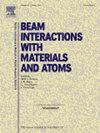Monte Carlo simulation of intragranular Xe bubble re-solution in UZr nuclear fuels
IF 1.4
3区 物理与天体物理
Q3 INSTRUMENTS & INSTRUMENTATION
Nuclear Instruments & Methods in Physics Research Section B-beam Interactions With Materials and Atoms
Pub Date : 2025-01-16
DOI:10.1016/j.nimb.2025.165623
引用次数: 0
Abstract
The bubble re-solution in UZr alloys plays a key role in the nucleation and growth of fission gas bubble, but its mechanism is still unclear. In this work, the behavior of Xe bubble re-solution due to binary collision affected by bubble radius, matrix composition, and fission fragments in UZr fuels has been carried out by 3D Monte Carlo method. The re-solution coefficient (b0) decreases with the increase of bubble radius (Rb), and it will increase with the increase of Zr concentration (CZr) because of the higher energy entering the bubble. Using typical fission fragments (Sr, and I), it is found that the re-solution coefficient with small atomic numbers is higher than that of low-energy fission fragments with large atomic numbers. Further, we obtain the re-solution coefficient as a function of bubble radius and Zr concentration, and give the effective re-solution coefficients () in the intermediate region and the inner region according to the available experimental data. The value of the intermediate region is close to that of existing model, while the re-solution coefficient in the inner region is 3 orders of magnitude higher. This also shows that the fission gas behaviors in different phases are obviously different, which need more atomic-scale calculations in future.

UZr核燃料中颗粒内Xe气泡再溶解的蒙特卡罗模拟
UZr合金中气泡的再溶对裂变气泡的成核和长大起着关键作用,但其机制尚不清楚。本文采用三维蒙特卡罗方法研究了UZr燃料中气泡半径、基体成分和裂变碎片对二元碰撞引起的Xe气泡再溶解行为的影响。再溶系数(b0)随着气泡半径(Rb)的增大而减小,随着Zr浓度(CZr)的增大而增大,这是由于进入气泡的能量增大所致。利用典型裂变碎片(Sr、I),发现原子序数小的裂变碎片的再解系数高于原子序数大的低能裂变碎片的再解系数。进一步,我们得到了气泡半径和Zr浓度的再溶解系数,并根据实验数据给出了中间区域和内部区域的有效再溶解系数(b0′)。中间区域的分辨系数与现有模型接近,而内部区域的分辨系数则高出3个数量级。这也说明了裂变气体在不同阶段的行为有明显的不同,这需要在未来进行更多的原子尺度的计算。
本文章由计算机程序翻译,如有差异,请以英文原文为准。
求助全文
约1分钟内获得全文
求助全文
来源期刊
CiteScore
2.80
自引率
7.70%
发文量
231
审稿时长
1.9 months
期刊介绍:
Section B of Nuclear Instruments and Methods in Physics Research covers all aspects of the interaction of energetic beams with atoms, molecules and aggregate forms of matter. This includes ion beam analysis and ion beam modification of materials as well as basic data of importance for these studies. Topics of general interest include: atomic collisions in solids, particle channelling, all aspects of collision cascades, the modification of materials by energetic beams, ion implantation, irradiation - induced changes in materials, the physics and chemistry of beam interactions and the analysis of materials by all forms of energetic radiation. Modification by ion, laser and electron beams for the study of electronic materials, metals, ceramics, insulators, polymers and other important and new materials systems are included. Related studies, such as the application of ion beam analysis to biological, archaeological and geological samples as well as applications to solve problems in planetary science are also welcome. Energetic beams of interest include atomic and molecular ions, neutrons, positrons and muons, plasmas directed at surfaces, electron and photon beams, including laser treated surfaces and studies of solids by photon radiation from rotating anodes, synchrotrons, etc. In addition, the interaction between various forms of radiation and radiation-induced deposition processes are relevant.

 求助内容:
求助内容: 应助结果提醒方式:
应助结果提醒方式:


